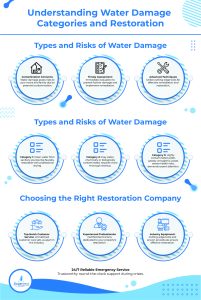The difference of Water Damage vs. Flood Damage
Water and flood damage are two types of damage caused by water, but they differ in several important ways.
Let’s discuss how different water damage & flood damage are.

Water Damage:
Water damage is caused by water entering a building from leaking pipes, roof damage, or appliance malfunctions. Typical water damage can be localized or widespread, depending on the source and duration of the water intrusion.
Common Causes of Water Damage include:
- Leaking pipes or plumbing fixtures
- Damaged roofs or gutters
- Malfunctioning appliances such as washing machines or dishwashers
- Natural disasters such as heavy rain or ice dams
Water damage can lead to mold growth, structural damage, electrical problems, and health hazards. Common signs of water damage include discoloration, warping or buckling of walls or floors, musty odors, and visible mold growth.
Preventive Measures of Water Damage
Preventing water damage is essential to protect your property and avoid costly repairs. Here are some preventive measures you can take to prevent water damage:
Regular Inspection and Maintenance:
Regularly inspecting and maintaining plumbing systems, appliances, and roofs can help prevent water damage. Check for leaks in pipes, faucets, and devices and address any issues promptly. Maintain gutters and downspouts to ensure proper drainage and prevent water from accumulating on the roof.
Install Water Alarms:
Water alarms can alert you to potential water leaks or flooding before they cause significant damage. These alarms can be installed near appliances or areas prone to water damage, such as basements or crawl spaces.
Water Damage Restoration Services in Reno, Nevada
Install Flood Barriers or Seals:
Flood barriers or seals around doors and windows can prevent water from entering the property during a flood. These barriers can be made from sandbags, rubber, or other materials and should be properly installed and maintained.
Monitor Water Bill:
Monitoring your water bill can help you detect potential water leaks. If you notice a significant increase in your water bill without any change in water usage, it may be a sign of a leak that needs to be addressed.
Maintain Proper Drainage:
Make sure the property has proper drainage to direct water away from the building. This can be achieved by grading the land around the building, installing a French drain, or using other drainage systems.
Check Your Insurance Coverage:
Check your homeowners or renters’ insurance policy to ensure it covers water damage. If not, consider purchasing additional coverage to protect your property in case of water damage.

Flood Damage:
Flood damage can cause significant problems for both commercial and residential buildings. Various factors, such as heavy rain, burst pipes, or overflowing toilets, can cause a flood.
In commercial buildings, indoor flood damage can result in the business’s closure and revenue loss. The damage can also affect valuable equipment, inventory, and supplies, leading to additional expenses. Restoration may require extensive repairs, including replacing walls, flooring, and electrical systems. In addition, there may be a need for mold remediation and water damage cleanup, which can further delay the reopening of the business.
For residential buildings, indoor flood damage can be devastating to the occupants, resulting in the displacement of families and damage to personal belongings. The cleanup and repair process may require significant financial resources and time. Restoration professionals may need to remove damaged materials, such as carpets, drywall, and insulation, and repair structural damage to the building. Furthermore, mold and other harmful contaminants may require additional remediation measures to ensure the safety of the occupants.
In both cases, indoor flood damage can have long-term effects on the building’s structural integrity and the health and safety of its occupants. It is essential to address indoor flood damage promptly and effectively to minimize the impact on the building and its occupants.
Hire a restoration company that can handle your claim correctly & maximize your coverage.
Insurance Coverage:
Homeowners’ or renters’ insurance policies may cover water damage caused by accidental events, but flood damage is typically not concealed. Flood insurance is a separate policy that must be purchased through the National Flood Insurance Program (NFIP) or a private insurer. Properties located in flood zones may be required to carry flood insurance as a condition of their mortgage.
Prevention and Mitigation:
Preventing water damage and flood damage requires different strategies. Some measures to prevent water damage include regular inspection and maintenance of plumbing systems, appliances, and roofs and proper drainage around the property. Preventing flood damage includes installing flood barriers, elevating electrical systems and devices above potential floodwaters, and avoiding buildings in flood-prone areas.

Conclusion
Water and flood damage are two types of damage caused by water but differ in their causes, scope, and severity. Insurance coverage and prevention strategies also differ for these types of damage, and it’s essential to understand the differences to protect your property and minimize damage.
SuperBest Water Damage & Flood Repair in Reno, Nevada, offers the finest water damage repair services in Sparks, Incline Village, Truckee, and Lake Tahoe. Call us 24 hours a day – any day of the year. We always answer our phones!
References and Links
USAA | Chubb | Geico | Progressive | Country
